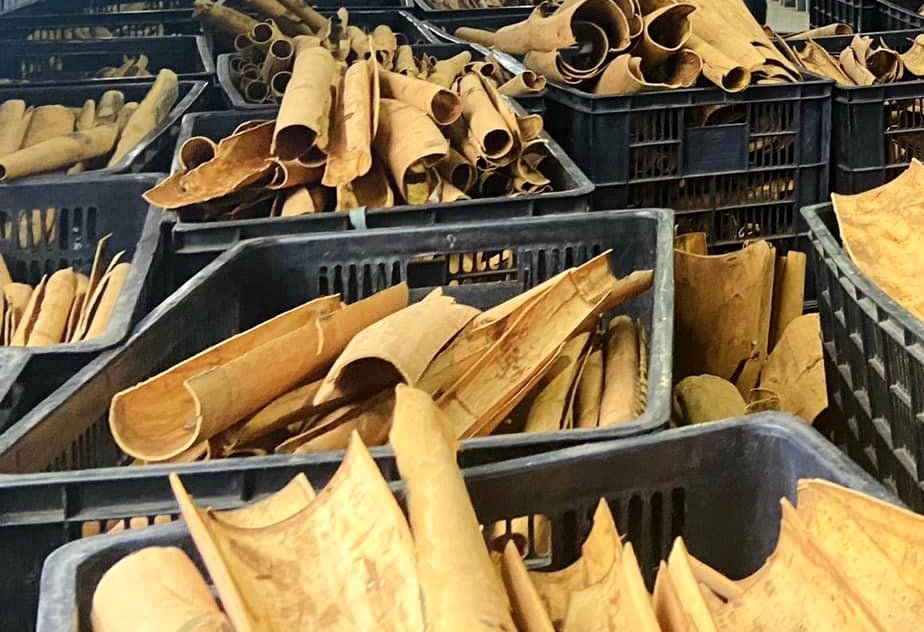November 27, 2025 | 23:53 GMT +7
November 27, 2025 | 23:53 GMT +7
Hotline: 0913.378.918
November 27, 2025 | 23:53 GMT +7
Hotline: 0913.378.918

Cinnamon - a key spice export of Vietnam. Photo: Son Trang.
According to the Vietnam Pepper and Spice Association (VPSA), the EVFTA signed on August 1, 2020, allowing for a 0% tariff rate on pepper and spice-related taxes. However, despite this, the export and market expansion to the EU still hasn't matched the potential of Vietnamese spices due to the rather high and stringent quality, origin tracing, and food safety standards of the EU market. For instance, in the case of pepper, the European Food Safety Authority currently has 507 maximum residue level indicators specified for this product.
Mrs. Tran Nhu Trang, an expert from SIPPO (Swiss Import Promotion Programme), noted that the EU is currently one of the important markets for Vietnamese spices, accounting for about 15% of the total exports. Nevertheless, looking back at the three years since the EVFTA came into effect, the export of Vietnamese spices to the EU hasn't fully utilized the advantages of this agreement. In practice, among the spice product groups that enjoyed reduced tariffs immediately after the EVFTA took effect, only both groups of ground or milled pepper achieved a 50% increase in value and market share. Other items increased, but they followed the trend of EU imports and haven't fully tapped into the potential of the EVFTA.
Additionally, the impacts of the Covid-19 pandemic, global economic crisis, the Russia-Ukraine conflict, etc., have also significantly affected the export of Vietnamese spices to the EU. In 2022, Vietnam's pepper export value to the EU decreased, leading to a reduction in market share to only 17.1% (in 2021, Vietnam accounted for 18.2% of EU's pepper imports).
In the first 6 months of 2023, pepper exports to the EU continued to decrease, while cinnamon exports increased by 26.1%. This is a positive signal amidst the high inflation in the EU's economy.

Farmers harvesting chili peppers in Vinh Long province. Photo: Son Trang.
VPSA's assertion highlights a favorable situation for Vietnam's pepper industry in its export endeavors to the EU market, especially when compared to Brazil. This advantageous position can be attributed to various factors such as favorable geographical conditions, diligent cultivation practices, and a strong focus on quality control. However, while Vietnam may currently enjoy this edge, it's important to recognize that maintaining a competitive advantage is an ongoing effort that requires proactive strategies.
To ensure that Vietnam remains a dominant player in the EU pepper market over the long term, it's crucial for the pepper industry to emphasize continuous quality improvement. This involves a comprehensive approach that covers all stages of production, from cultivation to processing and packaging. By implementing stringent quality standards, adhering to sustainable farming practices, and investing in modern technology, Vietnam can further enhance the flavor, aroma, and appearance of its pepper products. Such improvements will not only solidify its current advantage but also position the country as a preferred source for premium-quality pepper in the eyes of EU consumers.
In conclusion, while Vietnam's advantage in exporting pepper to the EU is commendable, sustaining this position requires a multi-faceted approach. Continuous quality improvement, diversification into different market segments, and embracing sustainability are pivotal strategies that can contribute to a strong and enduring presence in the EU pepper market. By proactively adapting to changing consumer preferences and market dynamics, Vietnam can fortify its position as a reliable and sought-after supplier of pepper in the EU and beyond.
Especially in the context where the EU is consistently updating and enhancing sanitary and quarantine measures, green growth criteria, and sustainable development for imported agricultural products, alongside the price competitiveness advantage, Vietnamese enterprises need to aim for competitiveness by satisfying stringent requirements and criteria from the EU. This will help them maintain their position and engage more deeply in other markets.
According to Mrs. Tran Nhu Trang, European consumers are increasingly seeking to explore and consume dishes from Asian, African, Middle Eastern, Japanese, etc., cuisines, favoring moderately spicy flavors. The use of spices is also on the rise due to their health benefits. To maintain and enhance competitiveness in the EU market, the Vietnamese spice industry needs to be ready to meet origin tracing requirements and ensure transparent information. In addition, accessing new distribution channels, strengthening promotional methods, and employing innovative communication strategies are essential. For instance, food bloggers writing about the use of Vietnamese spices in food preparation, incorporating them into daily meals, can be effective.
Translated by Nguyen Hai Long

(VAN) China’s cooking oil is suddenly flooding into India. It all comes down to a soybean surplus that Beijing doesn’t quite know what to do with.

(VAN) An Giang promotes supply-demand connections, standardizes quality and builds value chains, creating a foundation for sustainable bird’s nest development and aiming to expand exports.
/2025/11/24/5339-4-nongnghiep-075331.jpg)
(VAN) Recently, the conference on 'Sustainable Fisheries Linkage Chain - Tilapia for Export' took place in Tien Hai commune, Hung Yen province.
/2025/11/21/4309-2-153400_128.jpg)
(VAN) Green and low-emission rice is paving the way for Vietnamese rice to enter high-end markets, marking the beginning of a transformation journey toward greening and elevating the national rice brand.

(VAN) ‘Right to Win’ outlines a national action plan that shapes a new vision for Viet Nam’s agriculture in an era of renewal and global integration.

(VAN) Lam Dong’s farmed sturgeon output this year is expected to reach 2,300 tons, worth VND 450 billion, affirming the brand’s position on the market.

(VAN) A surge in Ukrainian egg exports, largely driven by soaring sales to the UK over the last few years, has notably pushed up egg prices on the domestic market.